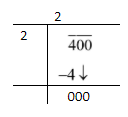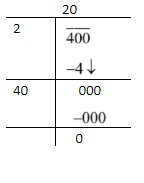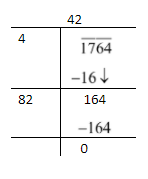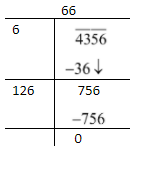
Find the square root by division method.
(i) 400
(ii) 1764
(iii) 4356
Answer
497.7k+ views
Hint:
For finding the square root of the given number, first, make pairs from the unit place. Now take the largest number whose square is equal to or just less than the number in the first bar from left. Now subtract the digit of the given number and the square of the number written in the quotient. Bring down the next pair. Then, take twice the number taken in the first place and add the unit digit to that number such that when that unit digit is multiplied with the number formed, it is equal to less than the current dividend. Repeat the process till you get remainder as 0.
Complete step by step solution:
We shall begin by making groups of 2 digits starting from the unit place.
Make the pair such as
Now, take the divisor as the largest number whose square is equal to or just less than the first digit in the bar from the starting digits of the given number.
As
Therefore, our divisor is 2. Subtract the first pair from the square of 2 and then bring the next pair down.
Now, we get,

Next, our dividend is 0.
Write the twice of the first divisor, which is
We will now find the unit digit placed with 2 such that when that digit is multiplied by the new number, the result is less than or equal to the dividend.
Therefore, we have
Hence, the next digit in the divisor is 0.

Now, the remainder is 0.
Hence, the square root of 400 is 20.
Now, in the same way, find the square root of 1764.

Hence, the square root of 1764 is 42.
Now, in the same way, find the square root of 4356.

Hence, the square root of 4356 is 66.
Note:
Many students make mistakes by making a pair from the starting of the number instead of a unit place, which gives the incorrect answer. Also, make sure when you bring down the digit, you take the whole pair and not the single digit.
For finding the square root of the given number, first, make pairs from the unit place. Now take the largest number whose square is equal to or just less than the number in the first bar from left. Now subtract the digit of the given number and the square of the number written in the quotient. Bring down the next pair. Then, take twice the number taken in the first place and add the unit digit to that number such that when that unit digit is multiplied with the number formed, it is equal to less than the current dividend. Repeat the process till you get remainder as 0.
Complete step by step solution:
We shall begin by making groups of 2 digits starting from the unit place.
Make the pair such as
Now, take the divisor as the largest number whose square is equal to or just less than the first digit in the bar from the starting digits of the given number.
As
Therefore, our divisor is 2. Subtract the first pair from the square of 2 and then bring the next pair down.
Now, we get,

Next, our dividend is 0.
Write the twice of the first divisor, which is
We will now find the unit digit placed with 2 such that when that digit is multiplied by the new number, the result is less than or equal to the dividend.
Therefore, we have
Hence, the next digit in the divisor is 0.

Now, the remainder is 0.
Hence, the square root of 400 is 20.
Now, in the same way, find the square root of 1764.

Hence, the square root of 1764 is 42.
Now, in the same way, find the square root of 4356.

Hence, the square root of 4356 is 66.
Note:
Many students make mistakes by making a pair from the starting of the number instead of a unit place, which gives the incorrect answer. Also, make sure when you bring down the digit, you take the whole pair and not the single digit.
Latest Vedantu courses for you
Grade 8 | CBSE | SCHOOL | English
Vedantu 8 CBSE Pro Course - (2025-26)
School Full course for CBSE students
₹45,300 per year
Recently Updated Pages
Master Class 12 Economics: Engaging Questions & Answers for Success

Master Class 12 Maths: Engaging Questions & Answers for Success

Master Class 12 Biology: Engaging Questions & Answers for Success

Master Class 12 Physics: Engaging Questions & Answers for Success

Master Class 4 Maths: Engaging Questions & Answers for Success

Master Class 4 English: Engaging Questions & Answers for Success

Trending doubts
In Indian rupees 1 trillion is equal to how many c class 8 maths CBSE

List some examples of Rabi and Kharif crops class 8 biology CBSE

How many ounces are in 500 mL class 8 maths CBSE

What is the feminine gender of a stag class 8 english CBSE

Give me the opposite gender of Duck class 8 english CBSE

Summary of the poem Where the Mind is Without Fear class 8 english CBSE




